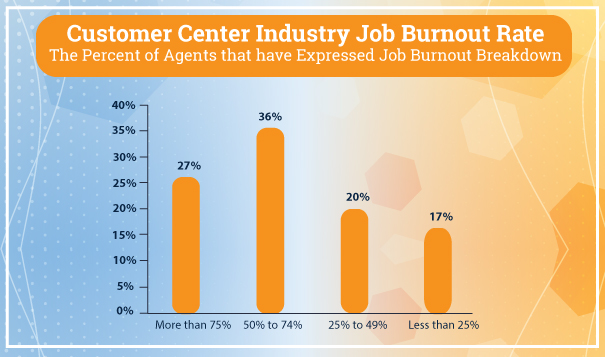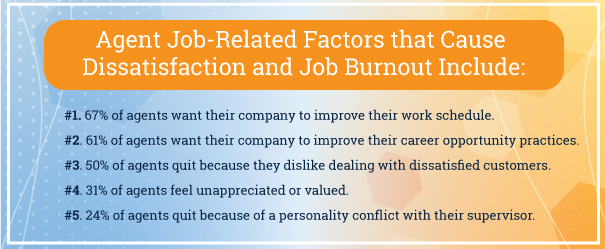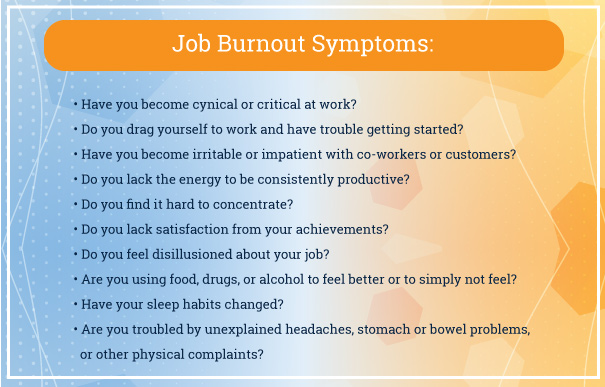Call Center Burnout Rate Problem
Call center agent burnout is a huge problem for companies. In fact, according to SQM Groups’ research, 88% of call center professionals completely (63%) or somewhat (25%) agree that it is one of the biggest challenges for the industry. For example, look at the call center industry's average annual agent turnover rate of 38%. Furthermore, based on SQM Group's research for tracking agent turnover for over 25 years, in 2022, the agent turnover rate was at an all-time high. Furthermore, agent burnout is one of the main contributors to the agent turnover issue.
The agent's job can be very stressful and easily susceptible to job burnout. SQM research shows that for the call center industry, 63% of agents have expressed a high job burnout rate (e.g., 50% or more of agents working at a call center level) within the last year. Most leaders are struggling with the increased call center burnout rate and recognize they need to develop and implement solutions to recover from it.
Job burnout is commonly associated with millennials but has risen among all age groups. In addition, increased call center stress and anxieties related to COVID-19 and economic instability have worsened job burnout. One primary aftereffect of COVID-19 is that agents are handling more dissatisfied customers. Customers often are angry, argumentative, disrespectful, and challenging to interact with to help them resolve their inquiry or problem.
It’s no wonder why agents get job burnout when over 30% of customers calling are to resolve an issue that was not resolved on a previous call or the fact that 14% of calls they handle customers define as complaint calls. The agent's job is challenging and stressful, and as a result, job burnout is a real problem.

We recommend that call centers conduct random employee surveys monthly or semi-annually with employees asking them questions to measure your call center’s job burnout rate.
Here are eight questions to ask agents to measure your call center burnout rate:
- Have you felt job burnout recently?
- How satisfied are you working as an agent at the call center?
- Do you get along with your coworkers?
- Do you get along with your supervisor?
- Is there enough support?
- Do you have a work-life balance?
- Are there growth opportunities?
- Do you feel recognized for your performance?
Agents that experience job burnout can be influenced and compounded by work-life balance, family life, financial and working-from-home isolation issues. But, of course, job-related factors can contribute to agent job burnout. Listed below are the top five factors that can cause agent job burnout.

What Is Call Center Burnout?
Call center burnout is when agents, supervisors, managers, and staff experience the following symptoms: energy depletion, exhaustion, fatigue, negativism, cynicism, increased mental distance from their job, and reduced efficacy. The call center burnout rate is a problem that has been an issue for a long time for most organizations but has significantly increased due to COVID-19.
According to Mayo Clinic, “job burnout is a special type of work-related stress - a state of physical or emotional exhaustion that also involves a sense of reduced accomplishment and loss of personal identity.”
Furthermore, job burnout isn't a medical diagnosis. Some experts think other conditions, such as depression, are behind burnout. In addition, researchers point out that individual factors, such as personality traits and family life, influence who experiences job burnout.
Whatever the cause, job burnout can affect your physical and mental health. Ask yourself the questions below to help determine if you might have job burnout.

7 Tips to Recover From High Call Center Burnout Rate
1. Recognize that an Agent has Job Burnout
According to Gallup, about two-thirds of full-time workers experience burnout on the job. Therefore, supervisors need to be good at recognizing when an agent has job burnout or when an agent tells them they have job burnout so they can show some empathy. If caught early enough, it will be easier to recover from versus if the agent has had job burnout for a long time.
Agents need to know that if they feel burnout, they need to share that information with their supervisor or someone in the human resource department, and there will be no negative implications. Furthermore, agents and supervisors need to be trained to recognize job burnout. Finally, agents and supervisors should ask themselves the job burnout symptom questions identified in the previous section.
Supervisors need to recognize that it is not an agent's fault that they got job burnout. However, agent job burnout might be attributed to their boss because of a personality conflict with their supervisor. Therefore, supervisors must know they contribute to an agent’s job burnout. The benefit of recognizing agent burnout has taken place is the agent and supervisor get a chance to do something to recover from it.
2. Take Care of Yourself
Prevention is better than cure, but when an agent has been identified as having job burnout, they need to take care of themself. Byran Robinson, Ph.D., describes seven steps to take care of yourself so that you can recover or prevent job burnout such as:
- Get lots of rest. Many people think they can push through burnout, but rest and relaxation are the best medicines.
- Practice self-care. The trifecta of burnout recovery is eating a healthy diet, getting ample sleep, and having a regular exercise regimen.
- Take micro-breaks. Taking five or ten minutes of micro-breaks throughout the workday helps you unwind and reset your energy level.
- Set work-life boundaries. Work-life balance is essential, especially if you’re a remote worker.
- Meditate. Practice relaxation exercises such as progressive muscle relaxation.
- Have a place to vent. Talk about your burnout with a stress buddy or someone you feel safe and comfortable with sharing your feelings.
- Get professional support. A Vida Health survey by Onepoll reported that 47% of workers believe taking advantage of mental health opportunities is a sign of weakness. A Visier study reported that only seven percent of burnt-out employees seek support for fear of being stigmatized as incompetent if they speak to a boss.
3. Real-time Support is Available
Agents need support when handling call interactions and feel supported. For example, the call center industry average for agents needing assistance on calls they handle is 20%. Agents put 46% of customers on hold to get more information and transferred 19% to another person to handle because they could not. Therefore, the majority of agents need real-time support. However, most agents feel that real-time support is poor or needs to be improved.
Did you know that 30% of customer calls are unresolved on the first call? And that in 40% of non-first call resolution (FCR) customer interactions, the source of error is agents. In many cases, the agent could not deliver FCR due to a lack of real-time support availability.
Since agents are handling more complex and dissatisfied customers, they should be able to take a non-scheduled break if they need to recover from a stressful call. But, again, 50% of agents quit because they dislike dealing with dissatisfied customers. Providing agents with real-time support for handling complex or dissatisfied customers and time off the phone can help reduce job burnout.
SQM Group’s research shows that over 80% of agents work from home, making providing real-time support more challenging. Therefore, call center managers should measure if agents feel they are getting enough real-time support to deliver high FCR and customer satisfaction.
4. Recognizing & Motivating
Agents need to feel recognized for the customer service they deliver. SQM Group has developed a work-from-home agent recognition solution to help lower job burnout and turnover by increasing employee engagement and motivating agents to improve customer service. Given that over 80% of agents work from home, having a recognition program that engages remote agents has become essential.
SQM's agent recognition program awards points based on post-call surveys, quality assurance, and internal data agent performance captured in mySQM™ Customer Service QA software.
mySQM™ Customer Service QA software helps recognize agents through award points earned that are converted to dollars and redeemed at most retailers using an SQM debit card. In addition, our powerful customer experience management (CXM) software tool motivates agents by providing frequent, descriptive, and meaningful recognition.
Awarding agents in real-time (e.g., right after a post-call survey or QA evaluation) is a fantastic way to acknowledge their performance when delivering excellent customer service. Furthermore, suppose agents feel there is a chance they could get rewarded for a call they just handled. In that case, they are more motivated to go the extra mile to deliver excellent customer service because of real-time recognition.
Our recognition program is one of the best practices for motivating agents to improve FCR and provide great customer service. For example, for every post-call survey that is a world-class call (e.g., the call is resolved and Csat is a top box response), the agent receives 25 award points that can be converted through gamification to an average payout of $40. So, if an agent had 50 world-class calls in a year, they would earn $2,000 in incentive pay.
The $2,000 incentive pay paid out in real-time is excellent from an agent's perspective. Moreover, most agents believe the gratification of earning dollars based on helping customers resolve their inquiries or problems is a crucial way to be recognized. Furthermore, being recognized for providing world-class customer service motivates agents to go the extra mile to resolve customer issues and significantly reduces agent issues for non-FCR calls.
5. Communicate all the Time
The stress level at a call center can be very high at times. Therefore, supervisors must invest more time in communicating with agents when stress levels are high. For example, increase agent coaching and team huddle sessions to help reduce stress and job burnout, if possible.
During stressful times, it is common for agents to be cynical or critical at work. To help avoid agents becoming cynical and critical, supervisors must communicate job responsibilities, expectations, tools, and training required to succeed. Supervisors should not assume the email or knowledge management tool will effectively cover the information the agent needs.
Supervisors need to show empathy to agents experiencing stress and burnout. Agents need to feel listened to and that the supervisor cares about helping them recover. Supervisor action and communication are essential to sustaining the balance between high levels of agent engagement and practices that replenish their focus and energy to handle complex customer interactions.
6. Training and Education Commitment
Many agents feel they do not have the knowledge, skills, and abilities to resolve calls. Therefore customers are dissatisfied, which is one of the primary reasons for causing agent burnout. However, in recent years, agent training initiatives have been put under the microscope to determine if the training initiatives have had a positive impact on FCR, call resolution, and customer satisfaction (Csat).
SQM's FCR research shows that few organizations can empirically prove that, due to their agent customer service soft skills training efforts, their FCR, call resolution, and Csat have increased. In addition, agent satisfaction with their ability to resolve calls has improved. High-performing FCR call centers still have high turnover compared to pre-COVID-19 but are usually lower than most other call centers.
Many call center managers are unaware of the impact of repeat calls on their Csat, agent job satisfaction, and job burnout. As a result, SQM is often asked: "How can I get my agents to improve their call resolution and reduce job burnout?" The following are call resolution training tips to help agents improve FCR and reduce stress:
- Train supervisors on how to coach agents to improve Voice of the Customer (VoC) performance and to engage agents so they are motivated to improve FCR, call resolution, and Csat
- Budget and adequately plan for providing agent call resolution two-day training
- Provide call resolution training for both new hires and existing agents
- Use agents as the mentor with the highest call resolution and Csat performance as the coach for job shadowing and peer mentoring for agent new hires or poor agent VoC performers
- Incorporate VoC repeat call reasons and solutions into new hire and ongoing agent training programs
- Provide call resolution classroom and/or e-learning training
- Use agent VoC customer service QA reporting software tool that can provide a dashboard view of call resolution and Csat performance and identifies opportunities to improve CX
7. Agent Desktop Applications that Help Provide Great CX
The three primary agent desktop software applications essential for helping agents succeed in consistently delivering great CX are:
Unified Agent Software Platform
Connects all of the call center’s software applications that agents typically access and brings them into a single unified platform. This approach makes it easier for an agent to resolve the call cost-effectively due to saving time by not using multiple applications and making it easier for agents to resolve calls and satisfy customers.
Customer Relationship Management (CRM)
CRM software is used for servicing customer inquiries or problems. The CRM provides agents with information about all customer interactions and is updated by agents in a standardized format to capture customer interactions and commitments. As a result, many call center practitioners believe CRM software is an essential tool for resolving calls.
Knowledge Management Tool (KMT)
Used to assist agents in resolving customer calls. Agent knowledge is central to the customer service experience to answer customer inquiries and provide all necessary information to resolve a customer’s inquiry.
Quick Related Links
First Call Resolution Comprehensive Guide Customer Satisfaction Comprehensive Guide 360-Degree Feedback Customer Service QA Good to Great Customer Service
